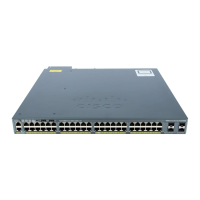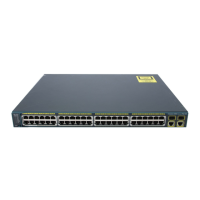•
All MST boundary ports must be forwarding for load-balancing between a per-VLAN spanning tree
plus (PVST+) and an MST cloud or between a rapid-PVST+ and an MST cloud. For this to occur, the
internal spanning tree (IST) master of the MST cloud should also be the root of the CST. If the MST
cloud consists of multiple MST regions, one of the MST regions must contain the common spanning
tree (CST) root, and all of the other MST regions must have a better path to the root contained within
the MST cloud than a path through the PVST+ or rapid-PVST+ cloud. You might have to manually
configure the switches in the clouds.
Related Topics
Specifying the MST Region Configuration and Enabling MSTP, on page 59
MSTP Configuration Guidelines, on page 44
Multiple Spanning-Tree Regions, on page 45
Restrictions for MSTP
•
The switch stack supports up to 65 MST instances. The number of VLANs that can be mapped to a
particular MST instance is unlimited.
•
PVST+, Rapid PVST+, and MSTP are supported, but only one version can be active at any time. (For
example, all VLANs run PVST+, all VLANs run Rapid PVST+, or all VLANs run MSTP.)
•
All stack members must run the same version of spanning tree (all PVST+, Rapid PVST+, or MSTP).
•
VLAN Trunking Protocol (VTP) propagation of the MST configuration is not supported. However, you
can manually configure the MST configuration (region name, revision number, and VLAN-to-instance
mapping) on each switch within the MST region by using the command-line interface (CLI) or through
the Simple Network Management Protocol (SNMP) support.
•
Partitioning the network into a large number of regions is not recommended. However, if this situation
is unavoidable, we recommend that you partition the switched LAN into smaller LANs interconnected
by routers or non-Layer 2 devices.
•
A region can have one member or multiple members with the same MST configuration; each member
must be capable of processing rapid spanning tree protocol (RSTP) Bridge Protocol Data Units (BPDUs).
There is no limit to the number of MST regions in a network, but each region can only support up to 65
spanning-tree instances. You can assign a VLAN to only one spanning-tree instance at a time.
•
After configuring a switch as the root switch, we recommend that you avoid manually configuring the
hello time, forward-delay time, and maximum-age time through the spanning-tree mst hello-time,
spanning-tree mst forward-time, and the spanning-tree mst max-age global configuration commands.
In a mixed MSTP and PVST+ network, the common spanning-tree (CST) root must be inside the MST
backbone, and a PVST+ switch cannot connect to multiple MST regions.
When a network contains switches running Rapid PVST+ and switches running PVST+, we recommend that
the Rapid PVST+ switches and PVST+ switches be configured for different spanning-tree instances. In the
Rapid PVST+ spanning-tree instances, the root switch must be a Rapid PVST+ switch. In the PVST+ instances,
the root switch must be a PVST+ switch. The PVST+ switches should be at the edge of the network.
All stack members run the same version of spanning tree (all PVST+, all Rapid PVST+, or all MSTP).
Catalyst 2960-XR Switch Layer 2 Configuration Guide, Cisco IOS Release 15.0(2)EX1
42 OL-29424-01
Configuring Multiple Spanning-Tree Protocol
Restrictions for MSTP

